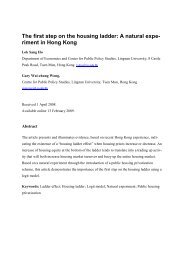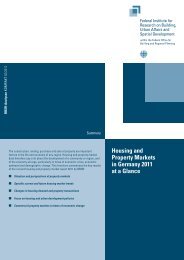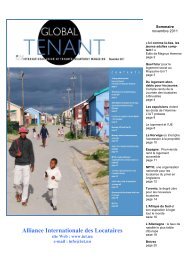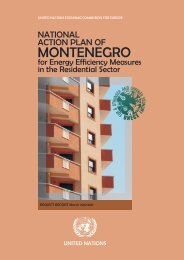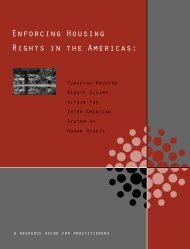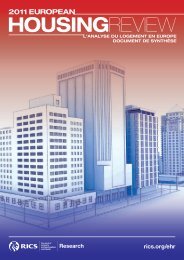condominium housing in ethiopia - International Union of Tenants
condominium housing in ethiopia - International Union of Tenants
condominium housing in ethiopia - International Union of Tenants
- No tags were found...
Create successful ePaper yourself
Turn your PDF publications into a flip-book with our unique Google optimized e-Paper software.
skim concrete or compacted earth floor. Larger multistoreycommercial and residential build<strong>in</strong>gs <strong>in</strong> urbanareas are composed <strong>of</strong> re<strong>in</strong>forced concrete frame and slabconstruction with hollow brick or fired brick <strong>in</strong>fill walls.There is a press<strong>in</strong>g need for more cost efficient alternativematerials, as the current cost <strong>of</strong> construction materialsis a high proportion <strong>of</strong> total construction cost, typicallyaround 70 per cent 52 .Figure 9: ‘Chikka’: the traditional construction material forresidential construction. © UN-HABITATThe construction <strong>in</strong>dustry comprises four ma<strong>in</strong>sectors: build<strong>in</strong>g and residential development sector(construction companies), civil eng<strong>in</strong>eer<strong>in</strong>g sector,pr<strong>of</strong>essional services, and <strong>in</strong>formal self-build<strong>in</strong>g sector 53 .Construction companies are classified accord<strong>in</strong>g tosize, expertise, and f<strong>in</strong>ancial capability. They must beregistered with the MWUD and licensed to undertakeconstruction work. There is little specialisation <strong>in</strong>contractors work, with contractors tak<strong>in</strong>g on all aspects<strong>of</strong> a build<strong>in</strong>g project (rather than specific tasks such asfoundations, structure, ro<strong>of</strong><strong>in</strong>g, etc) 54 .The pr<strong>of</strong>essional services sector comprises mostlyarchitects, eng<strong>in</strong>eers (mechanical, sanitary) and quantitysurveyors. Logically, the <strong>in</strong>formal self-build<strong>in</strong>g sector isnot registered but supplies materials and labour at a verylarge scale, employ<strong>in</strong>g a large number <strong>of</strong> people. There islittle cross-collaboration between the pr<strong>of</strong>essional sectorand <strong>in</strong>formal sector.Figure 10: Construction methods <strong>in</strong> Ethiopia are labour<strong>in</strong>tensive. © UN-HABITATThe national Ethiopian Build<strong>in</strong>g Code, EthiopianBuild<strong>in</strong>g Proclamation 624/2009 is a legal documentthat outl<strong>in</strong>es the build<strong>in</strong>g regulations and requirements,for use by local authorities to ensure build<strong>in</strong>g standardsare ma<strong>in</strong>ta<strong>in</strong>ed <strong>in</strong> their jurisdiction. Parts <strong>of</strong> Ethiopiaare located <strong>in</strong> an earthquake zone and a code exists toensure build<strong>in</strong>gs resist maximum predicted earthquakeloads. The codes are only used and enforced <strong>in</strong> build<strong>in</strong>gsdeveloped <strong>in</strong> the formal sector.The construction sector is undergo<strong>in</strong>g several changes.The government’s plan for the budget year <strong>of</strong> 2008/09was to enhance “the capacity <strong>of</strong> the construction <strong>in</strong>dustryby mak<strong>in</strong>g it capable and competitive, enhanc<strong>in</strong>g itscontribution to the country’s economy, enabl<strong>in</strong>g it tomeet the demand for <strong>hous<strong>in</strong>g</strong> construction, and enabl<strong>in</strong>git to create ample employment opportunities” 55 . It aimedto achieve this by improv<strong>in</strong>g construction <strong>in</strong>dustrypolicy; develop<strong>in</strong>g a construction <strong>in</strong>dustry capacitybuild<strong>in</strong>g programme; and ratify<strong>in</strong>g and implement<strong>in</strong>gthe national build<strong>in</strong>g proclamation 56 .Figure 11: Multi-storey build<strong>in</strong>gs <strong>in</strong> Addis Ababa are typicallyconstructed from cast <strong>in</strong>-situ re<strong>in</strong>forced concrete frame withbrick <strong>in</strong>fill walls. © UN-HABITAT8INTRODUCTION TO ETHIOPIA





